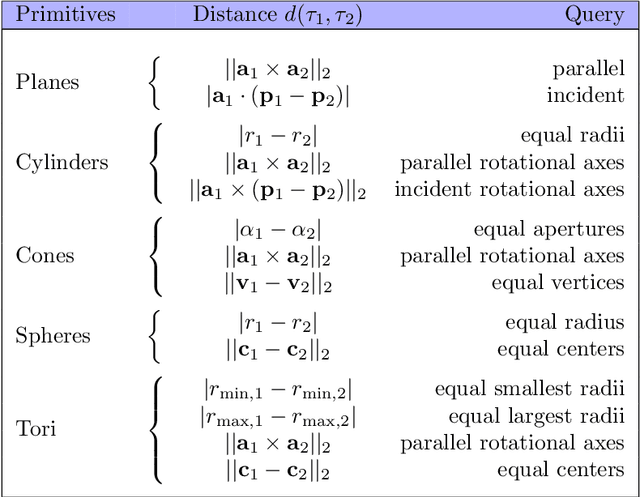Bianca Falcidieno
Recognising geometric primitives in 3D point clouds of mechanical CAD objects
Jan 11, 2023Abstract:The problem faced in this paper concerns the recognition of simple and complex geometric primitives in point clouds resulting from scans of mechanical CAD objects. A large number of points, the presence of noise, outliers, missing or redundant parts and uneven distribution are the main problems to be addressed to meet this need. In this article we propose a solution, based on the Hough transform, that can recognize simple and complex geometric primitives and is robust to noise, outliers, and missing parts. Additionally, we can extract a series of geometric descriptors that uniquely characterize a primitive and, based on them, aggregate the output into maximal or compound primitives, thus reducing oversegmentation. The results presented in the paper demonstrate the robustness of the method and its competitiveness with respect to other solutions proposed in the literature.
Fitting and recognition of geometric primitives in segmented 3D point clouds using a localized voting procedure
May 30, 2022



Abstract:The automatic creation of geometric models from point clouds has numerous applications in CAD (e.g., reverse engineering, manufacturing, assembling) and, more in general, in shape modelling and processing. Given a segmented point cloud representing a man-made object, we propose a method for recognizing simple geometric primitives and their interrelationships. Our approach is based on the Hough transform (HT) for its ability to deal with noise, missing parts and outliers. In our method we introduce a novel technique for processing segmented point clouds that, through a voting procedure, is able to provide an initial estimate of the geometric parameters characterizing each primitive type. By using these estimates, we localize the search of the optimal solution in a dimensionally-reduced parameter space thus making it efficient to extend the HT to more primitives than those that are generally found in the literature, i.e. planes and spheres. Then, we extract a number of geometric descriptors that uniquely characterize a segment, and, on the basis of these descriptors, we show how to aggregate parts of primitives (segments). Experiments on both synthetic and industrial scans reveal the robustness of the primitive fitting method and its effectiveness for inferring relations among segments.
Fit4CAD: A point cloud benchmark for fitting simple geometric primitives in CAD models
May 14, 2021



Abstract:We propose Fit4CAD, a benchmark for the evaluation and comparison of methods for fitting simple geometric primitives in point clouds representing CAD models. This benchmark is meant to help both method developers and those who want to identify the best performing tools. The Fit4CAD dataset is composed by 225 high quality point clouds, each of which has been obtained by sampling a CAD model. The way these elements were created by using existing platforms and datasets makes the benchmark easily expandable. The dataset is already split into a training set and a test set. To assess performance and accuracy of the different primitive fitting methods, various measures are defined. To demonstrate the effective use of Fit4CAD, we have tested it on two methods belonging to two different categories of approaches to the primitive fitting problem: a clustering method based on a primitive growing framework and a parametric method based on the Hough transform.
Recognition of feature curves on 3D shapes using an algebraic approach to Hough transforms
Sep 28, 2017



Abstract:Feature curves are largely adopted to highlight shape features, such as sharp lines, or to divide surfaces into meaningful segments, like convex or concave regions. Extracting these curves is not sufficient to convey prominent and meaningful information about a shape. We have first to separate the curves belonging to features from those caused by noise and then to select the lines, which describe non-trivial portions of a surface. The automatic detection of such features is crucial for the identification and/or annotation of relevant parts of a given shape. To do this, the Hough transform (HT) is a feature extraction technique widely used in image analysis, computer vision and digital image processing, while, for 3D shapes, the extraction of salient feature curves is still an open problem. Thanks to algebraic geometry concepts, the HT technique has been recently extended to include a vast class of algebraic curves, thus proving to be a competitive tool for yielding an explicit representation of the diverse feature lines equations. In the paper, for the first time we apply this novel extension of the HT technique to the realm of 3D shapes in order to identify and localize semantic features like patterns, decorations or anatomical details on 3D objects (both complete and fragments), even in the case of features partially damaged or incomplete. The method recognizes various features, possibly compound, and it selects the most suitable feature profiles among families of algebraic curves.
 Add to Chrome
Add to Chrome Add to Firefox
Add to Firefox Add to Edge
Add to Edge